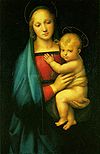- Basilica of the National Shrine of Our Lady of Aparecida
-
Basilica of the National Shrine of Our Lady Aparecida
Basílica do Santuário Nacional de Nossa Senhora Aparecida
Basílica do Santuário Nacional de Nossa Senhora Aparecida
Basic information Location Aparecida, Brazil Affiliation Roman Catholic Ecclesiastical or organizational status Minor basilica Architectural description Architect(s) Benedito Calixto Architectural type Church Specifications Capacity 70,000[1] Length 568 feet (173 m) Width 551 feet (168 m) Height (max) 328 feet (100 m) Dome height (outer) 229 feet (70 m) The town of Aparecida, in the SE region of the State of São Paulo, Brazil, houses two basilicas dedicated to Brazil's Patroness Saint, Nossa Senhora da Conceição Aparecida, or "Our Lady of the (Immaculate) Conception who Appeared," a reference to the appearance of the head, then the body of a statue of Mary in the Paraiba river to fishermen who were having a hard time catching fish for a dinner to the emperor who slept over in their village. After they found and fixed the image of Mary, a miracle would have been happened and their fish net could not contain so many fish. Other miracles are reported to have been granted by God through the invocation and intercession of the Virgin, including one to an enslaved African-Brazilian boy. Perhaps because of his origin and the fact that the statue had been darkened by clay, Lady Aparecida is often portrayed as Black with Portuguese features, since the original statue was probably brought from Portugal.
The "basilica velha," or "old basilica" is a modest small church with colonial tendencies in style, built between 1760 and 1770 and restored from 1824 to 1834.It was established as a minor basilica by Pope Saint Pius X in 1908. The "basilica nova," or "new basilica," took years to be built and was already being used for services, ceremonies, and pilgrimage in the late 1960s and beginning of the 1970s. During his first visit to Brazil in 1980, Pope John Paul II dedicated the temple to God Almighty under the invocation of Lady Aparecida and the date of the appearance of the image of the Virgin, October 12, became a national holiday observed yearly ever since. The date is also celebrated as Marian holiday under the invocation of "Nossa Senhora de Nazare'," or "Our Lady of Nazareth" in the city of Belem, capital of the northern state of Para'.
The much larger building of the new basilica became necessary due to the popular devotion to Lady Aparecida, under whose intercession many Brazilian Catholics claim to have received favors and pay her homage by visiting the temple. They often bring ex-voto offerings or fulfill vows such as by approaching the shrine of the Madonna, or its replica, on their knees. Thus, in 1955 construction of the new basilica started. Acclaimed church architect and fresco painter Benedito Calixto, who has painted among other things, the frescoes and the ceiling of the Lady of Mount Carmel basilica in São Paulo, designed a building in the form of a Greek cross, 173 m (567 ft) long and 168 m (551 ft) wide; the dome reaches 70 m (229 ft) and the steeple rises to 105 m (334 ft), placing it also amongst the largest churches in the world, holding up to 45,000 people. The 272,000 square meters of parking hold 4,000 buses and 6,000 cars.
The building was consecrated by Pope John Paul II while still under construction, on July 4, 1980.[2] The Pope created the church as a Minor Basilica and named it the most important National Marian Shrine in Brazil.
The New Basilica is now the second or third largest Catholic place of worship in the world, depending on definitions of size. St. Peter's Basilica in Vatican City is the largest and the Basilica of Our Lady of Peace of Yamoussoukro in Ivory Coast has been mentioned as the second largest but consists mostly of empty, unused space.
In 1984, Lady Aparecida was officially declared as "the largest Marian Temple in the world." According to the official site of the basilica, in 1999 the number of pilgrims was 6,565,849.
Pope Benedict XVI visited the Basilica of the Shrine of the Aparecida on May 12, 2007, during his Apostolic Journey to Brazil on the occasion of the 5th General Conference of the Bishops of Latin America and the Caribbean.[3] The Pope awarded the Shrine a Golden Rose on that occasion.
See also
References
General articles
Overview of Mariology •
Veneration of the Blessed Virgin • History of MariologyExpressions of devotion
Art • Hymns • Music • ArchitectureSpecific articles
Apparitions • Saints • Popes • Societies • Hearts of Jesus & Mary • Consecration to MaryExternal links
Coordinates: 22°51′2.10″S 45°14′1.81″W / 22.850583°S 45.2338361°W
Categories:- Basilica churches in South America
- Marian shrines
- Recipients of the Golden Rose
- Roman Catholic churches in Brazil
Wikimedia Foundation. 2010.

